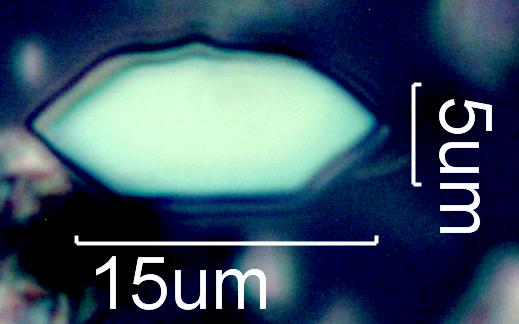Calcium Oxalate Phytolith from Wild Rose (Rosa nutkana) leaves
This is one of the bipyramidal crystals from the leaves of wild rose (Rosa nutkana). These phytoliths were collected by digesting wild rose leaves in sodium hypochlorite solution (Bleach).
Definition/Function:
KINGDOM: Plantae UNRANKED: Angiosperms UNRANKED: Eudicots UNRANKED: Rosids ORDER: rosales FAMILY: Rosaceae GENUS: Rosa SPECIES: nutkana
Calcium oxalate phytoliths of wild rose are whewellite, CaC2O4-H2O. They commonly form in prisms and druse crystals or aggregates.Significance in the Environment:
Characteristic Features:
Whewellite is monoclinic with a beta angle of 107 degrees. The ratio of the cell parameters is 0.862 : 1 : 1.371, a:b:c. "b" = 7.29 Angstroms. The refractive indices are 1.490, 1.553, and 1.650 for a birefringence of 0.160. Whewellite is optically positive with a 2V of about 84 degrees.
This form of prism is similar to that found in pine needles but the pine prisms in this form have a much higher aspect ratio (length/width). The angles here are 74, 144, and 142 degrees approximately.
Associated Particles:
References:
1. Blinnikov, Mikhail, "Phytoliths in plants and soils of the interior Pacific Northwest, USA", REVIEW OF PALAEOBOTANY & PALYNOLOGY, vol. 135, pp. 71-98, 20052. Franceschi, Vincent R. and Harry T. Horner Jr., "Calcium oxalate crystals in plants", THE BOTANICAL REVIEW, vol. 46, No. 4, Oct-Dec 1980, pp. 361-427.
3. Piperno, Dolores R., PHYTOLITHS, AltaMira Press, 2006.
4. Rapp, George Jr. and Susan C. Mulholland (eds), PHYTOLITH SYSTEMATICS, Plenum Press, 1992.
5. Madella, M., A. Alexandre, and T Ball, "International Code for Phytolith nomenclature 1.0", ANNALS OF BOTANY, 2005,available on line at http://aob.oxfordjournals.org/cgi/reprint/mci172v1
6. http://en.wikipedia.org/wiki/Phytoliths


